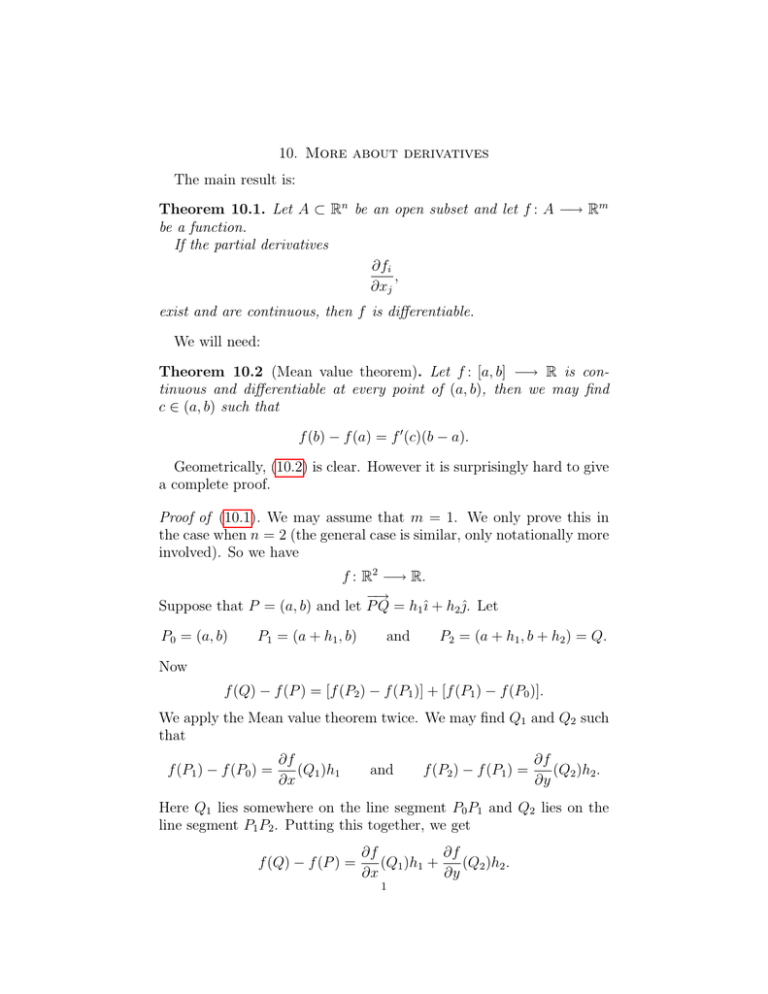Document 13403712
advertisement

10. More about derivatives
The main result is:
Theorem 10.1. Let A ⊂ Rn be an open subset and let f : A −→ Rm
be a function.
If the partial derivatives
∂fi
,
∂xj
exist and are continuous, then f is differentiable.
We will need:
Theorem 10.2 (Mean value theorem). Let f : [a, b] −→ R is con­
tinuous and differentiable at every point of (a, b), then we may find
c ∈ (a, b) such that
f (b) − f (a) = f � (c)(b − a).
Geometrically, (10.2) is clear. However it is surprisingly hard to give
a complete proof.
Proof of (10.1). We may assume that m = 1. We only prove this in
the case when n = 2 (the general case is similar, only notationally more
involved). So we have
f : R2 −→ R.
−→
Suppose that P = (a, b) and let P Q = h1ˆı + h2 j.
ˆ Let
P0 = (a, b)
P1 = (a + h1 , b)
and
P2 = (a + h1 , b + h2 ) = Q.
Now
f (Q) − f (P ) = [f (P2 ) − f (P1 )] + [f (P1 ) − f (P0 )].
We apply the Mean value theorem twice. We may find Q1 and Q2 such
that
f (P1 ) − f (P0 ) =
∂f
(Q1 )h1
∂x
and
f (P2 ) − f (P1 ) =
∂f
(Q2 )h2 .
∂y
Here Q1 lies somewhere on the line segment P0 P1 and Q2 lies on the
line segment P1 P2 . Putting this together, we get
f (Q) − f (P ) =
∂f
∂f
(Q1 )h1 +
(Q2 )h2 .
∂x
∂y
1
Thus
−→
|( ∂f
(Q1 ) −
|f (Q) − f (P ) − A · P Q|
∂x
=
−→
�P Q�
∂f
(P ))h1
∂x
+ ( ∂f
(Q2 ) −
∂y
−→
�P Q�
∂f
(P ))h2 |
∂y
∂f
∂f
|( ∂f
(Q1 ) − ∂f
(P ))h1 | |( ∂y (Q2 ) − ∂y (P ))h2 |
∂x
∂x
≤
+
−→
−→
�P Q�
�P Q�
∂f
∂f
|( ∂f
(Q1 ) − ∂f
(P ))h1 | |( ∂y (Q2 ) − ∂y (P ))h2 |
∂x
∂x
≤
+
|h1 |
|h2 |
∂f
∂f
∂f
∂f
= |( (Q1 ) −
(P ))| + |( (Q2 ) −
(P ))|.
∂x
∂y
∂y
∂x
Note that as Q approaches P , Q1 and Q2 both approach P as well. As
the partials of f are continuous, we have
−→
|f (Q) − f (P ) − A · P Q|
∂f
∂f
∂f
∂f
lim
≤ lim (|( (Q1 )− (P ))|+|( (Q2 )− (P ))|) = 0.
−
→
Q→P
Q→P
∂y
∂y
∂x
∂x
�P Q�
Therefore f is differentiable at P , with derivative A.
�
Example 10.3. Let f : A −→ R be given by
x
f (x, y) = �
,
2
x + y2
where A = R2 − {(0, 0)}.
Then
∂f
(x2 + y 2 )1/2 − x(2x)(1/2)(x2 + y 2 )−1/2
y2
=
=
.
∂x
x2 + y 2
(x2 + y 2 )3/2
Similarly
∂f
xy
=− 2
.
∂y
(x + y 2 )3/2
Now both partial derivatives exist and are continuous, and so f is dif­
ferentiable, with derivative the gradient,
y2
xy
1
�f = ( 2
,− 2
)= 2
(y 2 , −xy).
2
3/2
2
3/2
2
3/2
(x + y )
(x + y )
(x + y )
Lemma 10.4. Let A = (aij ) be an m × n matrix.
If �v ∈ Rn then
�A�v � ≤ K��v �,
where
�
K=(
a2ij )1/2 .
i,j
2
Proof. Let �a1 , �a2 , . . . , �am be the rows of A. Then the entry in the ith
row of A�v is �ai · �v . So,
�A�v �2 = (�a1 · �v )2 + (�a2 · �v )2 + · · · + (�an · �v )2
≤ ��a1 �2 ��v �2 + ��a2 �2 ��v �2 + · · · + ��an �2 ��v �2
= (��a1 �2 + ��a2 �2 + · · · + ��an �2 )��v �2
= K 2 ��v �2 .
Now take square roots of both sides.
�
Theorem 10.5. Let f : A −→ Rm be a function, where A ⊂ Rn is
open.
If f is differentiable at P , then f is continuous at P .
Proof. Suppose that Df (P ) = A. Then
−→
f (Q) − f (P ) − A · P Q
lim
= 0.
−→
Q→P
�P Q
This is the same as to require
−→
�f (Q) − f (P ) − A · P Q�
lim
= 0.
−→
Q→P
�P Q
But if this happens, then surely
−→
lim �f (Q) − f (P ) − A · P Q� = 0.
Q→P
So
−→
−→
�f (Q) − f (P )� = �f (Q) − f (P ) − A · P Q + A · P Q�
−→
−→
≤ �f (Q) − f (P ) − A · P Q� + �A · P Q�
−→
−→
≤ �f (Q) − f (P ) − A · P Q� + K�P Q�.
Taking the limit as Q approaches P , both terms on the RHS go to zero,
so that
lim �f (Q) − f (P )� = 0,
Q→P
and f is continuous at P .
�
3
MIT OpenCourseWare
http://ocw.mit.edu
18.022 Calculus of Several Variables
Fall 2010
For information about citing these materials or our Terms of Use, visit: http://ocw.mit.edu/terms.




